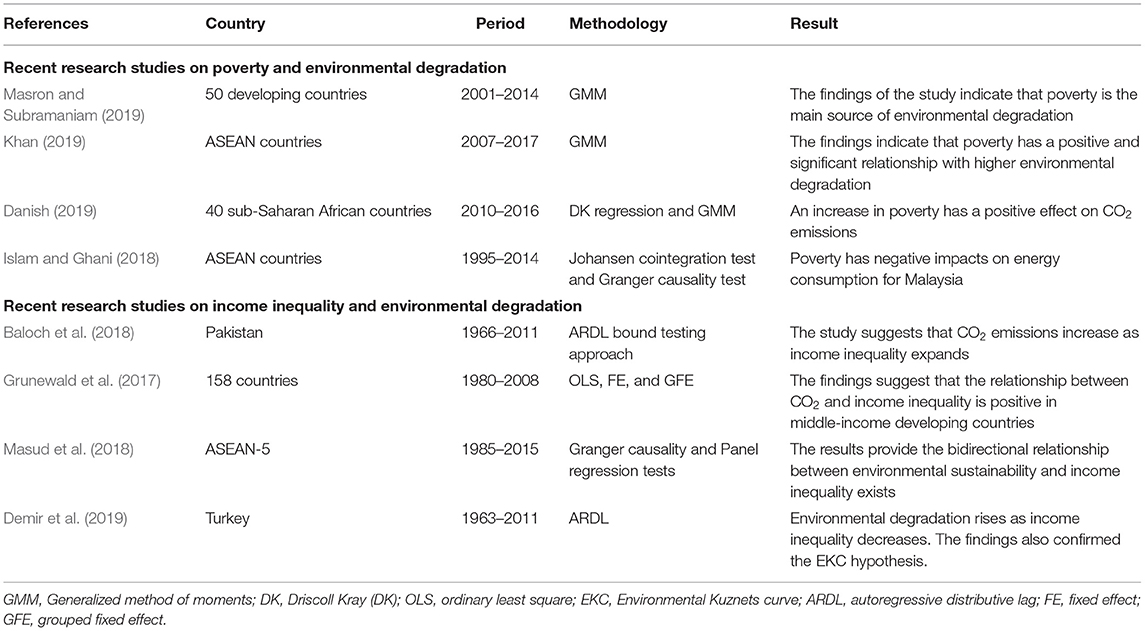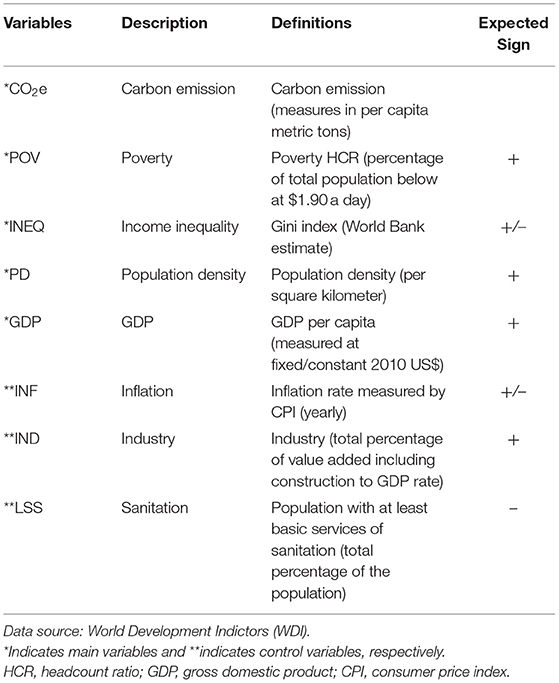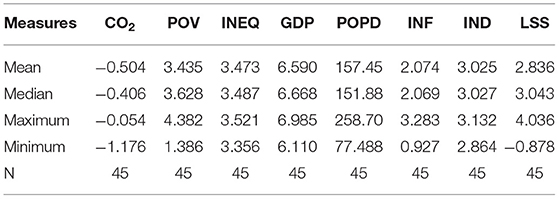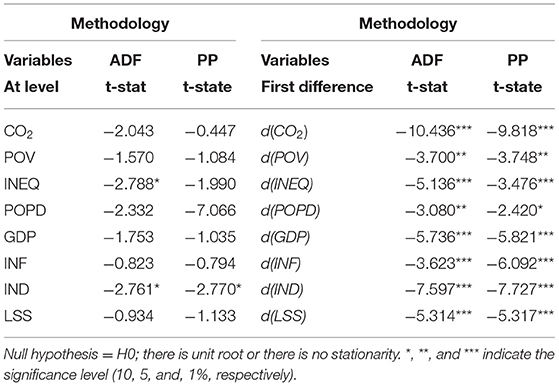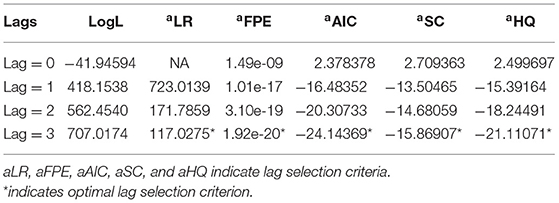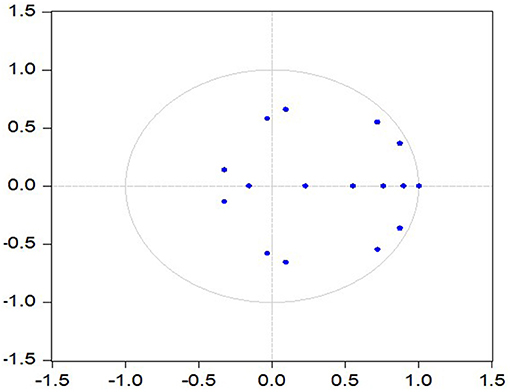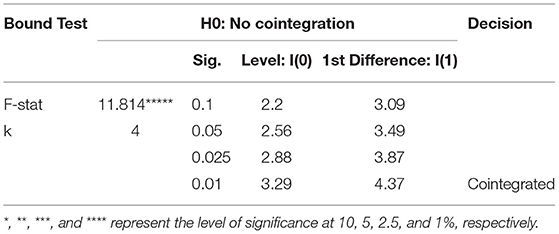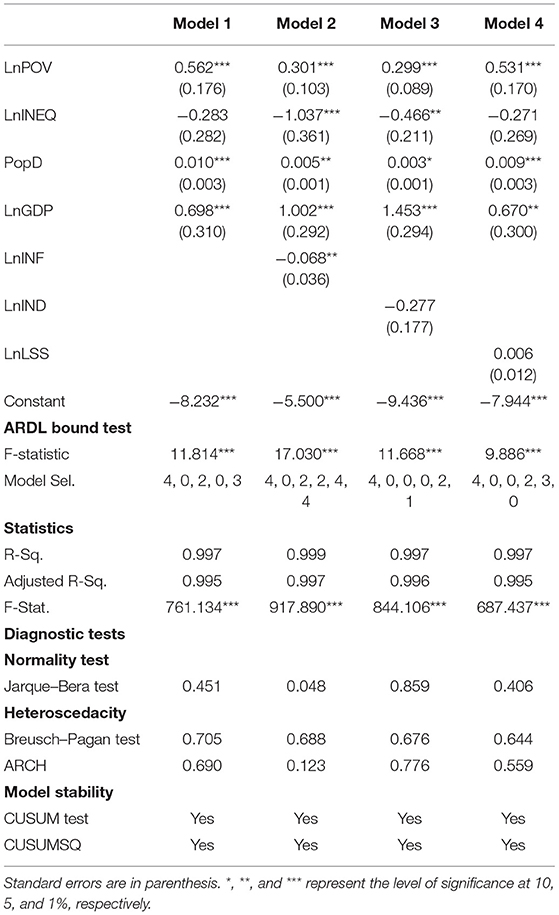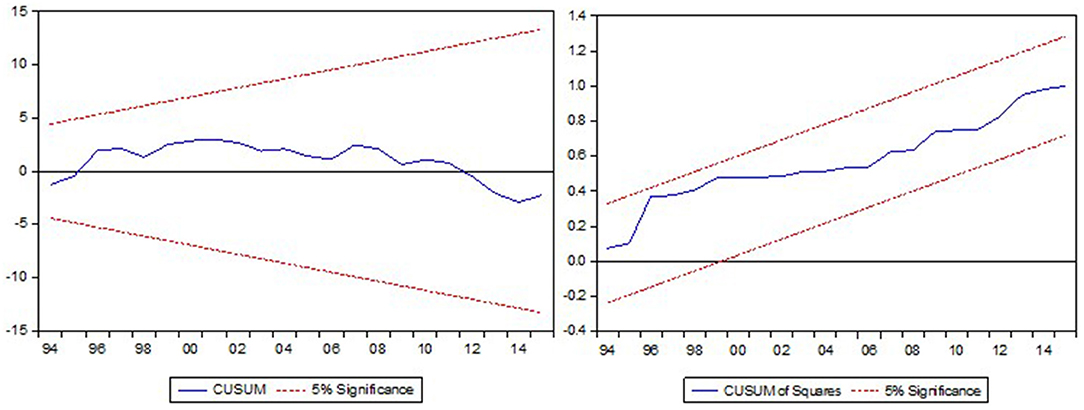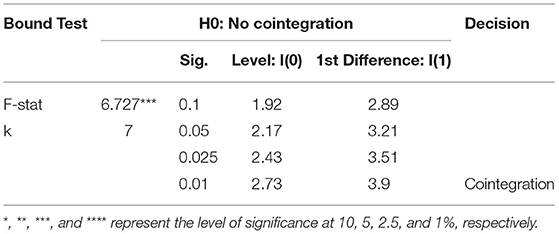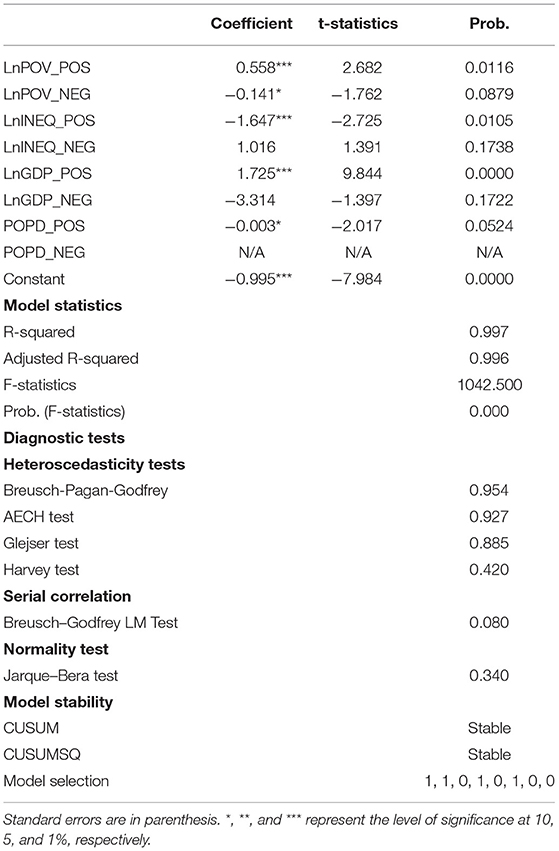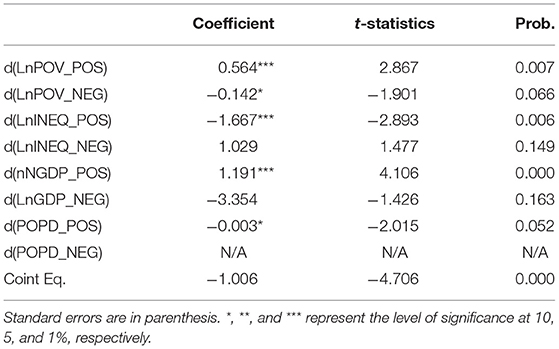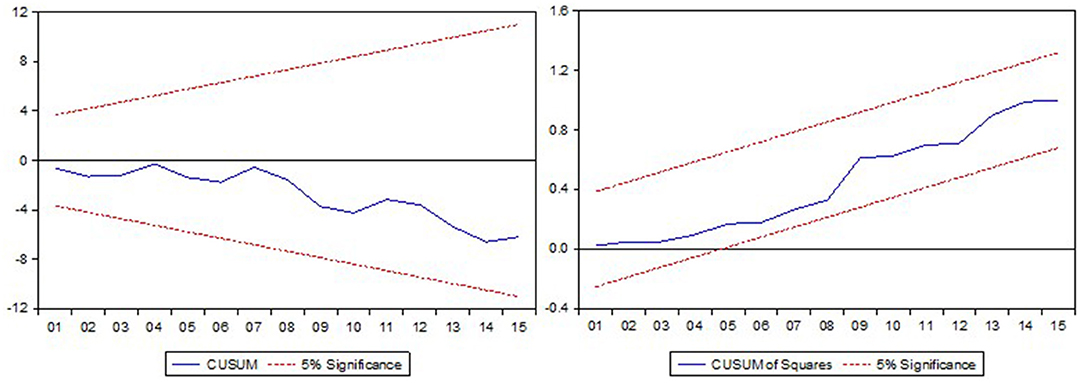- 1School of Tourism and Management, Zhengzhou University, Zhengzhou, China
- 2School of Business, Zhengzhou University, Zhengzhou, China
Several researchers have studied the relationship between poverty and environmental degradation, as these concerns are remained at top priority in achieving Sustainable Development Goals (SDGs). However, the symmetric and asymmetric impact of poverty and income inequality along with population and economic growth on carbon emissions (CO2e) has not been studied in the case of Pakistan. For this purpose, the short and long-run impact of poverty, income inequality, population, and GDP per capita on CO2e investigated by applying the Autoregressive Distributive Lag (ARDL) along with Non-linear Autoregressive Distributive Lag (NARDL) co-integration approach in the context of Pakistan for period 1971–2015. The symmetric results of the current study show poverty and population density along with GDP per capita increase carbon emissions in both the short and long-run, while income inequality has no impact on carbon emissions in the short-run. While in the long-run the symmetric results show that income inequality weakens environmental degradation in terms of carbon emissions. The analysis of NARDL also supports the results obtained from ARDL and suggests a positive effect of poverty, population, and economic growth on carbon emission in Pakistan. The empirical findings of the current study provide policy implications in light of the United Nation's SDGs for the development of Pakistan.
Introduction
Increasing environmental degradation in terms of carbon dioxide emissions, (CO2e) is a major threat to the quality of the environment and for the sustainable development of many countries. The ongoing environmental degradation has placed numerous countries under pressure to decrease CO2e and to focus on low-carbon emitter economies. As a result, many small and large series of agreements, such as the “Paris Agreement,” “Kyoto Protocol,” and the “United Nations Framework Convention on Climate Change” (UNFCCC) have been made among different developing and developed countries to control and decrease CO2e. The reduction of CO2e has become important in recent years because many industrialized and developed countries have applied their policies to mitigate Co2e (Zhang et al., 2014; Adusah-Poku, 2016; Yang et al., 2017). However, the ongoing concerns for sustainable development have increased over the years as the quality of the environment has declined because of economic activities. Environmental changes and alleviation of poverty are the main concerns and agendas in the sustainable development goals (SDGs) of the UN. All the countries around the globe, including developing countries, have decided to release mankind from extreme poverty and to provide them with clean and safe atmosphere (Maji, 2019). To achieve higher economic growth, mostly less developed countries boost their economic activities to reduce extreme poverty by encouraging production units and the level of industrialization. However, the main aim of economic activities to accelerate economic growth, which raises greater energy demand that further leads to a rise in CO2e, adversely affect sustainable development and the well-being of humans (Sani et al., 2017; Danish, 2019; Qamruzzaman and Jianguo, 2020). Sustainable development and economic growth are supportive to the alleviation of extreme poverty, particularly, if they are not associated with environmental degradation and income inequality. Numerous research studies (Baloch et al., 2020) have explored the nexus between CO2e and income inequality and advocated that a rise in the level of income gap depreciates the quality of the environment at a certain point. Ultimately, from the perspective of underdeveloped nations like Pakistan, the nexus between CO2e and income inequality might decrease poverty, but at the same time, it increases environmental degradation (Grunewald et al., 2017). However, the association of extreme poverty and income inequality along with population, economic growth and environmental pollution has been overlooked in many countries, particularly, in developing countries like South Asia, including Pakistan. Many studies have focused mainly on other environmental issues in the developed countries, while the empirical studies on developing economies like Pakistan, to the extent of past literature reviews, are very few.
South Asia is economically less developed and one of the poorest regions of the world. Many developing countries of South Asia face extreme poverty, income inequality, population growth, and environmental degradation. It is also observed that less developed countries (LDCs) are more vulnerable to achieve the targets of SDGs as compared to other developed countries (DCs). We have concentrated on the economy of Pakistan because Pakistan is continuously struggling to improve its economic growth and development, reduce all types of inequalities (particularly income), eradicate extreme poverty, and to control population growth so as to raise the quality of life of its impoverished people. Every productive activity aims to diminish extreme poverty which is responsible for high production and high consumption of energy and thus CO2e in Pakistan, the energy supply in Pakistan, is based on fossil fuels (Baloch et al., 2018). With the higher energy consumption, Pakistan is facing serious issues regarding environmental degradation since the emission of deadly and toxic wastes contaminate the quality of water and air. Furthermore, Pakistan has an agricultural economy and the increasing usage of insecticides (pesticides) badly affects the quality of water (groundwater). Besides, the higher degree of deforestation and rapid urbanization also increase the environmental degradation. For the last many years, Pakistan and other developing countries have continued to post a substantial increase in environmental degradation in terms of CO2e and have postulated very severe threats to the quality of the environment. Among other developing countries, Pakistan only accounts for 0.70% of the world's CO2e in 2013. As reported by the International Energy Agency (IEA) in 2013, the total production of CO2e is more than 321.2 million tons in Pakistan, while this is augmented more than 2-fold from about 151 million tons during the nineteen-nineties (Heubaum and Biermann, 2015). However, the contribution of Pakistan to Greenhouse emission (GHS) is not very high, but the emission of carbon has been increasing severely and thus has become the main problem to environmental degradation.
Moreover, despite the current climate and environmental changes in Pakistan, the country has still faced extreme poverty, a dramatic increase in income inequality, and high population growth. The negative environmental changes might place a negative and significant impact on the economy, as many people in the developing countries are mostly in a vulnerable position and are suffering from the absence of human capital (education and health) to alleviate the negative impacts of environmental degradation (Awodumi and Adewuyi, 2020; Yahong and Khan, 2021). The Pakistani economy is gradually growing, but it is still on the list of the poorest country in the world. From the prevailing economic situations, it is observed that the extreme poverty level may not be alleviated in Pakistan by 2030, but it can be reduced through equal distribution of income and continuous economic growth. Most notably, it is also recorded that Pakistan could not achieve the target of poverty reduction and millennium development goals (MDGs), because of the extending income gap (Abdullah et al., 2015; Arshed et al., 2020). Although, struggles are being made against poverty alleviation, many regions in the country are static and suffering from extreme poverty due to lack of basic needs, such as education, health, and clean drinking water, as well as low income of <$1.9 a day (Munir and Khan, 2014; Akbar et al., 2018). According to the World Bank (Khan M. K. et al., 2020), a decreasing tendency is seen in the poverty headcount ratio (HCR), subsequently after 1995, but millions of people are still living below the extreme poverty line. For instance, according to Global Consumption and Income Project (Lahoti et al., 2015), inequality in terms of the Gini coefficient has risen from 22% in 1960 to 43% in 2015.
In the meantime, an increasing trend in income inequality badly affects different economic and social classes of the society. The underprivileged and poor societies are very badly affected by an uneven income distribution, since they are predominantly a vulnerable part of the society. Further, the extended income gap leads to high CO2e by creating hurdles in the path of environmental policies. Likewise, it might decrease ecological security and ultimately cause greater CO2e. Meanwhile, large number of studies stated that the stability of environmental quality could be a substantial factor to reduce the intensity of poverty (Schleicher et al., 2018; Butt et al., 2020). Environment and natural resources are helpful to reduce extreme poverty levels by providing better health, access to healthy foods, and provide opportunities for income generation. It is also reported that the environmental quality can be improved by reducing extreme poverty, because most poor people living in rural areas are highly dependent on natural resources, consequently manipulating environmental resources in an unsustainable way that leads to the degradation of the quality of the environment (Qin, 2020; Baloch et al., 2021). In 1987, the World Commission published a report on Development and Environment and stated that extreme poverty degrades the quality of the environment. Moreover, the degradation of environmental quality can be controlled by reducing extreme poverty, as extreme poverty level, coupled with a growing population leads to depreciation in the quality of the environment and discourages the absorbing capacity (Rai, 2019).
In 2016, WB reported that more than half of the poor people belong to African and Asian countries. Most of them are not well-educated and (or) even uneducated and they enormously rely on natural (environmental) resources for their daily survival. Consequently, around 299 million hectares of land have been degraded due to defenestration. Many studies have been conducted on poverty–environment nexus, for instance, the work of Brundtland (1987) identified the association between poverty and environmental degradation and hypothesized that poverty is the main indicator of environmental pollution. Baloch et al. (2018) explored that relative poverty (income inequality) degrades the quality of the environment. Similarly, Khan M. I. et al. (2020) explored that economic growth, growth of the stock market, foreign direct investment (FDI), and oil consumption distrust the quality of the environment. Hence, the factual association between poverty, income inequality, and other economic variables with environmental degradation is not clear, and becomes the main objective and key motivation to conduct this study. The fulfillment of the study objective by resolving the problem of poverty and income inequality may help to mitigate environmental degradation and improve sustainability along with strong and green economic development. As discussed above, in less-developed regions, most people are poor and they may have to manipulate environmental resources blindly for their daily survival, which will degrade the quality of the environment (Grossman and Krueger, 1995). According to the work of Khan (2019), majority of emerging and developing economies in countries, such as Pakistan, Tajikistan, Bulgaria, Uzbekistan, and Costa Rica magnificently reduce their extreme poverty level without environmental degradation. Hence, the current study posits a few key research questions, such as what impact do poverty, income inequality, and population has on CO2e in the case of Pakistan? The current study tried to answer these questions by aiming to examine the nexus between poverty and income inequality along with population and economic growth on CO2e. The main contribution and novelty of the current study are discussed below.
First, the current research not only focuses on the effect of absolute poverty and relative poverty on CO2e, but also on the impact of population on CO2e as well. The empirical findings of the current study would provide valuable insight into how absolute as well as relative poverty influences environmental degradation in terms of CO2 emissions. Secondly, the current study used population density and other control variables, in the environmental degradation model to avoid possible specification bias in the model. Thirdly, the current study has incorporated new evidence from NARDL cointegration to analyze long-run asymmetries as well as short-run dynamics between the variables used in the model (Shin et al., 2014). To do so, we will have to assess how the decrease and increase in the poverty HCR and income inequality along with population and GDP per capita (economic growth) have an impact on CO2e. Besides, we have also incorporated a linear ARDL model to identify the long-run symmetries as well as the short-run association between variables (Pesaran et al., 2001).
The whole study is organized in five sections, such as Section I, Introduction and Section II, Review of the literature; similarly, Section III covers Materials and methods, while Section IV comprises the Empirical Finding along with explanation, and Section V consists of Conclusion of the current study.
Review of the Literature
The current research study empirically analyzes the association between poverty and income inequality, along with the population and GDP per capita on CO2e in Pakistan. For a better understating, the Review of the literature was divided into three sub-sections, in which the first part contains the association between CO2e and poverty HCR; similarly, in the second and third parts of the literature review, we address the impact of income inequality along with population on CO2e.
Relationship Between Poverty and CO2e
Alleviation of extreme poverty holds significance among government authorities and policymakers, as it is one of the key millennium development goals (MDGs). The impact of absolute poverty on environmental quality in the form of CO2e has been studied by many social and environmental scientists. This issue also has been acknowledged in previous research studies; however, empirical evidence backing the “poverty–CO2e relationship” is often not easy to get. There are progressive discussions in recent research studies regarding the relationship between poverty and the quality of the environment. Many researchers considered that extreme poverty is a key predictor of environmental degradation, particularly, in the LDCs. According to Koçak et al. (2019), extreme poverty along with a high population leads to feeble environmental safety strategies which raise pressure on natural means (means of production or environmental resources) and deteriorate the environment. Moreover, extreme poverty leads to deterioration in the quality of land and causes a higher amount of CO2e because poor and needy people waste natural resources (such as cutting of trees) for their economic well-being and survival. There is also a group of environmental economists who supports the two-way relationship of causality between environmental degradation and poverty. They suggested that both poor as well as rich people, contribute to the misuse of natural resources and environmental degradation, but the rich people get less affected than the impoverished because impoverished people are looked upon as victims as well as agents of environmental degradation. Few research studies had pointed out the association between environmental degradation and poverty, but these estimations are still inconclusive, while most of the studies failed to provide an inclusive and clear estimation on the nexus between poverty and environmental pollution. These most recent and related research studies on these issues are cited in Table 1. On behalf of the above-mentioned arguments and sparse literature, the current study provides the following four hypotheses.
Hypothesis I: Poverty has an impact on CO2e emission in Pakistan.
Relationship Between Income Inequality and CO2e
The analysis of income inequality along with economic growth and other economic indicators is extended and attracted the interest of the researchers, but the analysis of income inequality along with degradation of the environment has not been acknowledged with sufficient consideration and therefore it enters as an emerging and hot research phenomenon in the empirical literature. The literature on the income gap and environmental degradation can be classified into two parts. The first part of the literature deals with the Environmental Kuznets Curve (EKC), by analyzing the impact of the income gap on environmental degradation. Most of these studies documented that higher inequality in income degrades the environmental quality. For example, Boyce (1994) suggested that income inequality badly affects the quality of the environment. The estimation of Torras and Boyce (1998) supported the positive and direct impact of income inequality on environmental degradation. The most recent literature includes the studies of Easterlin and Angelescu (2012), Shahpouri et al. (2016), and Adelegan and Out (2020) who stated that the policies of the government regarding environmental issues deviate due to political power and income inequality; impoverished masses bear both the economic and terrible environmental costs, while the wealthy people only bear the economic costs. Moreover, the direct and positive effect of inequality on environmental degradation would further bring climate change and consequently, more polluted environment. On the other hand, various studies empirically proved that there is a negative impact of income inequality on the quality of the environment. For example, Hailemariam et al. (2020) proved that wider income inequality mitigates environmental degradation. This viewpoint relies on the marginal propensity to emit (MPE), in which environmental degradation varies as the distribution of income changes. Although these two viewpoints are different, they confirmed that environmental degradation in terms of CO2e and income inequality has a strong nexus. These most recent and related research studies on these issues are cited in Table 1. To verify this relationship, we hypothesized further.
Hypothesis II: Income inequality has a relationship with CO2e emissions in Pakistan.
Relationship Between Population and CO2e
The current study uses poverty and income inequality by incorporating population not just for the sensitive examination but also to evaluate its separate effect on CO2e. Past research studies suggest that high population growth causes economic uncertainty, thereby negatively affecting the economic growth and development (Rit, 2014; Berger and Grabert, 2018). This type of socio-economic uncertainty also affects CO2e emissions through a multiplier effect; therefore, on one hand, it discourages investment-saving behavior, research and development (R&D), and energy consumption as well (Sun, 2014; Harting, 2019), whereas, on the other hand, it motivates the vulnerable people to find and use the cheaper source of energy, for example, fossil fuel (Khan, 2019). Thus, in light of the above discussion, we hypothesized that population has a statistically significant impact and vital role in the emission of CO2e in the case of Pakistan. For that reason, we further proposed the third hypothesis.
Hypothesis III: Population has an impact on CO2e emission in Pakistan.
Materials and Methods
Model
From the discussions in the previous papers, this empirical research uses poverty, income inequality along with population, and GDP per capita to analyze the influence of poverty, income inequality, and population on environmental degradation in terms of CO2e emissions in Pakistan. While considering these relationships, we adopted the framework of empirical analysis similar to the empirical work of Hao et al. (2016) and Baek and Gweisah (2013). To verify the impact of poverty, income inequality, and population, we analyzed them with few control predictors so that we do not omit any important CO2e influencing factors. Besides, we transformed all variables into a logarithmic form to eliminate heteroscedasticity as shown in Table 2. Further, we estimated the following empirical model:
where, LnCO2et represents the log form CO2e per capita, LnPOVt represents poverty HCR; LnINEQt represents the Gini coefficient measure of income inequality, POPDt represents population density, and LnGDPt represents the GDP per capita. CONt represents the control group of variables which are as follows: LnINFt indicates the logarithm of annual inflation rate, LnINDt represents the density of population (per square kilometer), and LnLSSt represents the logarithm of population using minimum elementary water sanitation services. Besides, small t (t) represents the years, while the error term or residual in Equation 1 is εt. The detailed list of variables along with their descriptions and definitions are elaborated in Table 2.
For the analysis of the current study, we used the yearly data from 1971 to 2015, where most of the data have been collected from World Development Indicators (WDI), while for the missing data, we used the methodology of linear imputation (LI). Table 3 lists all the variables with their descriptive statistics.
Unit Root Tests
Before assessing the long- and short-run dynamics of the model, we used unit root tests to check the level of stationarity in each series. Past studies provide the ideas of multiple tests regarding stationarity; nevertheless, in the present study, most commonly used unit root tests, namely “Phillips–Perron” (PP) along with “Augmented Dickey–Fuller” (ADF) has been incorporated. We have checked the level of stationarity at the “level” [I(0)] and the “first difference” [I(1)] of all the variables, as shown in Table 4. Both PP and ADF unit root testing approaches of stationarity suggest that all variables in the log form are stationary at I(1).
Lag Selection Criteria Tests
For the analysis of cointegration, lag lengths are very essential. Table 5 illustrates the findings for optimal lag selection criteria. All criteria of optimal lags selection (LR = sequential modified likelihood ratio, FPF = final prediction error, AIC = akaike information criterion, SC = Schwarz information criterion, HQ = Hannan–Quinn information criterion) provide the lag order length of 3 for the estimation of cointegration. Additionally, lag order selection criteria (under VAR = vector autoregressive) estimates have also been established as shown in Figure 1. All small dots within the circle of polynomial graph confirm the suitability of lag selection of 3 for the policy implications and decision making.
Autoregressive Distributive Lag Under Cointegration Modeling
For the analysis of the long-run dynamic in the model, past research studies had proved many empirical modeling techniques. For instance, Johansen and Juselius (1990) and Johansen (1988) broadly used the full information of the maximum likelihood method for multivariate cointegration analysis, while Peter and Hansen (1990) and Engle and Yoo (1987) used the fully modified ordinary least square (OLS) and univariate cointegration analysis. Despite the fact, that Johansen techniques of cointegration are preferred and commonly used over other cointegration techniques, they can provide two or more cointegration linkage and can accommodate small (minimum 30) and biased sample, but it is essential that all variables of the model(s) should be integrated with the same direction. However, Pesaran et al. (2001) used the ARDL model to overcome the problem with Johansen cointegration. In the current study, the techniques of ARDL were applied to perform cointegration analysis among the variables of interest. The ARDL bounds testing approach has many benefits than any other method. For example, firstly, the ARDL provides robust estimates by effectively accommodating endogeneity among the variables, overcomes the serial correlation, and uses the appropriate selection of lags. Second, ARDL could be applicable for small sample size, as it is similar to Johansen's cointegration model (Odhiambo, 2009). Third, the ARDL technique has fewer requirements for integration, since the application of ARDL model does not require all variables integrated in the same direction (order), while it is different from the cointegration technique of Johansen. We can use ARDL methodology even when the variables are I (0), I (1), or a combination of both. Fourth and lastly, at the same time, ARDL bounds testing approach estimates the dynamics of both the short- and long-run in the model.
Based on the above mentioned selected time-series data and advantages of the ARDL model, in the current study, we proceeded with a similar method to inspect the influence of poverty and income inequality along with the population and economic growth on CO2e. The ARDL model is specified as follows:
Equation 2 is the ARDL bounds testing approach under the unrestricted error correction model (UECM), where ΔlnCO2e, ΔlnPOV, ΔlnINEQ, ΔPOPD, and ΔlnGDP represent their respective difference values. Similarly, β2, β3, β4,and β5represent the short-run dynamic relationship in the model, while λ1, λ2, λ3, λ4, and λ5 indicate the dynamical relationship in the long run. Likewise, P explains the lag length of each variable (both dependent and independent variables). The ARDL bounds testing approach uses F-statistics or Wald for a joint (mutual) significance test to examine if there is any long-run or cointegration relationship.
In order to carry out the statistical diagnostic tests for the stability of the model and to estimate the short- and long-run coefficients, Equation 3 explains the short-run, where ϑi explains the adjustment speed of the equilibrium after some short-run economic shocks.
NARDL Methodology
Similar to the simple ARDL model, the applications of NARDL methodology do not have the need for all variables (included in the model) to be integrated in the same r direction. By proceeding with the method of Shin et al. (2014), we used the methodology of NARDL to capture the asymmetric relationship (non-linear relationship) among the variables; to do so, we used the current estimates in the following model:
In Equation 4, , , t, and t explain the positive variation in poverty, income inequality, population and GDP per capita, respectively. While, β2ΔlnPOV−t, β4ΔlnINEQ−t, β6ΔPOPD− t and β8ΔlnGDP−t represent the negative variation in poverty, income inequality, population, and GDP per capita, respectively.
By following the same procedures as proceeded under simple methodology of ARDL, we have applied different stationarity tests (unit root tests) on lnPOV+, lnPOV−, lnINEQ+, lnINEQ−, POPD+, POPD−, and lnGDP+lnGDP−. The resulting probabilities of unit root tests found that all variables have no unit root and are stationary even at the I(1), while the lag order selection criteria suggested that the lag of 3 would be suitable for the NARDL methodology technique. After this, we used the NARDL model to examine the asymmetric association between the variables of interest.
Results
Estimation of ARDL Model
Before estimating the long- and short-run analysis, we inspected the bounds cointegration testing approach using the joint-F significance test to identify whether variables of the study are cointegrated (in the long-run). The calculated F-values and the level of significance (10, 5, 2.5, and 1%) are illustrated in Table 6, along with lower I(0) and lower I(1) critical values.
The tabulated (fixed) values of the upper bound I(1) are less than the computed F-values, and Narayan (2005) (with intercept and without trend) are highly significant even at 1% (0.1) level. The above-stated procedures confirmed that there is a long-run association of poverty (HCR), income inequality population density, and economic growth (GDP per-capita), and CO2e.
This section provides the empirical findings of long-run dynamics as well as short-run dynamics; we used the ARDL approach to quantify the nexus between HCR of poverty, income inequality (Gini index), population (population density), GDP per capita, and CO2e for Pakistan. In this study, we have converted mostly variables (used in the model) into log form; for this reason, the probabilities of resulted coefficients can be interpreted as elasticity in the long term.
As reported in Tables 7, 8, the resulting coefficients of ARDL estimates suggest that the association between poverty and CO2e is positive and statistically significant even at one percent. These findings indicate that the increasing trend of poverty in Pakistan positively influence CO2e which leads to environmental degradation. The empirical findings of the current study have verified that some serious steps are to be taken for the alleviation of extreme poverty which degrades the quality of environment in Pakistan. There might be different and large number of reasons for the positive impact of poverty (HCR) on environmental degradation in terms of CO2e. One is the indirect mechanism of CO2e and poverty; for example, to accelerate the process of industrialization, reduction of poverty might be one of the reasons to raise the level of intensity of environmental degradation in terms of CO2e. Encouraging and accelerating the process of industrialization is the key to enhance economic activities that will lead to higher economic growth, and therefore, reduce the intensity of extreme poverty (Khan M. I. et al., 2020). This process also worsens the quality of the environment (Jin et al., 2018). The empirical findings of our current study are consistent with the research findings of Dhrifi et al. (2020) and Masron and Subramaniam (2019) for developing countries, Lu (2017) for 24 Asian countries, and Khan (2019) for the Association of Southeast Asian Nations (ASEAN) countries. Whereas, the result of the current study might differ from few studies, such as Abid (2016) for African countries, Koçak et al. (2019) for LDCs, Zaidi et al. (2019) for Sub-Saharan Africa, and Islam and Ghani (2018) for ASEAN countries, since the economic dynamics of these countries and regions are different from Pakistan. Furthermore, our study incorporated a different method to examine this relationship. In addition, the present study indicates a different scenario and existence of conflict of policy makers so as to pay attention to environmental protection events or to boost economic growth in Pakistan. Such inconsistent scenario grabs the policymakers and government authorities because it is not easy to focus on issues related to the quality of the environment to be of the top priority in devising a policy (Abid, 2016).
Concerning the income gap and CO2e, the relationship is presented in Tables 7, 8. The resulting coefficients of income inequality (Gini index) on CO2e suggest a negative and highly significant impact on environmental degradation, that is, the negative trend in inequality leads to increase in CO2e. In other words, high-income inequality contributes to lower environmental degradation in Pakistan. One of the possible explanations might be that the lower value of Gini index in the least developed countries like Pakistan might decrease economic competition and the affordability to buy high-carbon emitting and energy-consuming sources among disadvantaged people. Therefore, lack of economic competition leads to a low environmental-friendly source of energy and thus high environmental degradation in terms of CO2e. Another reason is that the narrow income gap in developing countries like Pakistan weakens the people to invest in new and high-emitting technology to increase their income and thereby lower the CO2e (Demir et al., 2019; Uddin et al., 2020). The result of the current study is interesting and contrary to the work of Boyce (1994), who suggested that the higher-income gap creates a power gap between the upper class and lower class in a society that most probably worsens the quality of the environment. Because of different economic statuses, rich people take advantage, but environmental costs are levied on poor people. According to Boyce (1994), increasing income inequality can increase CO2e and environmental degradation. By increasing the income gap between the rich and poor, high-privileged people could not exploit natural resources for the sake of their luxury life, indicating that high-income inequality is environmentally friendly but poses a big socioeconomic problem. The result of the current study is consistent with the empirical findings of Uddin et al. (2020) for the Group of Seven countries (G7), Wang and Ye (2017) for China, Kounetas (2018) for European countries, Grunewald et al. (2017) for Third World nations, and Demir et al. (2019) for Turkey. Based on the current study, we believe that this inconsistency in the result is not the same as in Pakistan, and this study incorporated different research techniques to get the results.
Regarding population, the result of ARDL shows that there is a direct and statistically significant relationship between population density and environmental degradation in both the long- and short-runs, while the positive and significant coefficients for population density are varied within the models (1), (2), (3), and (4). From these results, it is inferred that population is also the main cause for the degrading environment in Pakistan. A possible explanation could be that the increasing rate of population leads to more people, while more people require more resources; consequently, the natural resources of earth deplete more rapidly. The main result of resource depletion is deforestation and loss of biodiversity as humans strip the earth off resources to accommodate and adjust the rising number of the population. The findings of the current study, supported by the work of Bakhsh et al. (2017), in the short-run as well as in the long-run are also consistent with the findings of Islam and Ghani (2018), for ASEAN countries. However, these findings are not in line with the work of Munir and Khan (2014) for the developing countries in Asia, and Hao et al. (2016) for China. The above researchers found an indirect relationship between population and environmental degradation. According to them, better-quality of infrastructure and more grounded ecological transmission bound higher population density areas, which lead to environmental sustainability.
As reported in Tables 7, 8, the result of ARDL methodology show that there is a positive and statistically significant relationship between GDP per capita and environmental degradation in case of Pakistan, thus signifying that the GDP per capita rises CO2e in the short-run as well as in the long-run. Particularly, the findings of this study are comparable with the work of Adedoyin et al. (2020) for BRICS economies, Ali et al. (2020) for Nigeria, Khan (2019) for ASEAN countries, Malik et al. (2020) for Pakistan, Lu (2017) for developing countries, Usman et al. (2020) for upper middle income countries (UMICs), and Zhang et al. (2014) for China. From the empirical results of this study, we are able to conclude that the existing economic growth and economic activities in developing countries like Pakistan contribute to the reduction of extreme poverty but with high environmental costs in the shape of environmental degradation.
Regarding the control group, the impact is as follows: (i) in the long-run, inflation has a negative and statistically significant effect on CO2e, where our findings are consistent with the recent work of Khan (2019) and Malik et al. (2020) for Pakistan. (ii) We failed to find any statistically significant influence of industry, the value-added share of GDP, and least basic sanitation services (% of the total population) on environmental degradation in Pakistan. In other words, the industry, value-added share of GDP, and least basic sanitation services do not cast any impact on CO2e in the case of Pakistan.
Diagnostic Tests and Stability of ARDL Model
Regarding model diagnostic and model stability tests, each model presented in Table 7 provides the empirical results for the diagnostic tests. First, we incorporated the Jarque–Bera test for the normality of data, where the critical value of Chi-square test is higher than 5%, indicating statistically insignificance and failed to reject the H0 of normal distribution, meaning that the data is normally distributed. While, for heteroscedasticity, we incorporated Breusch–Pagan (BP) test along with ARCH test and found the resulting probability value of the Chi-square test to be statistically insignificant, suggesting that we failed to reject the null hypothesis of homoscedasticity. Besides, for the provision of the robust results of the models, we conducted and tested the stability of all models incorporating the cumulative sum of recursive residual (CUSUM) and cumulative sum of recursive residual square (CUSUMSQ) (Brown et al., 1975). Figure 2 illustrates the graphical results for CUSUM and CUSUMSQ, which suggest the dynamic stability for all the models.
Estimation of NARDL Model
As suggested in Table 9, the computed (critical value) F-values (6.727) are greater than the tabulated value (3.9) of the 0(1) (lower bound) as well as I(I) (upper bound) of constant (intercept) and no trend that are found to be statistically significant even at 1% level (Narayan, 2005). These results established a long-run relationship among the CO2e, POPD, LnPOV_Pos, LnPOV_neg, LnGINI_Pos, LnGINI_neg, LnGDP_Pos, and LnGDP_neg.
The results of both the long-run non-linear ARDL and short-run NARDL long-run are presented in Tables 10, 11. The resulted coefficients of NARDL and the relationship between poverty HCR are positive and statistically significant. The results of both the short- and long-run NARDLs are consistent with the results of the long and short-run ARDLs as mentioned in Tables 7, 8. The asymmetric relationship between poverty and CO2 emissions are direct (positive shocks in the partial sum of poverty HCR), while the decrease in poverty HCR (negative shocks in the partial sum of poverty HCR) does not cast a statistically significant impact on CO2e. The result of negative shocks of poverty on CO2e for both the short and long-runs are statistically insignificant even at the 5% level, while the findings of positive shocks of poverty on CO2e are positive and statistically significant. Similarly, the results of GDP per capita (positive shocks) are statistically significant and positive in both the short- and long-run NARDLs, suggesting a positive impact of GDP per capita on environmental degradation. The income inequality (positive shocks) consistently suggests a negative and statistically significant impact on CO2e. In the case of both the short- and long-run associations between population density and CO2, an upsurge in the population (positive shocks of population density) increases the CO2e, whereas a reduction in the population (negative shocks of population density) does not apply.
The diagnostic tests of the model are also presented in the lower part of Table 10, where the findings failed to reject the null hypothesis of normality, heteroscedasticity, and model stability. Figure 3 illustrates the graphical results for CUSUM and CUSUMSQ for NARDL, which suggest the dynamic stability for all the models.
Discussion and Conclusion
In order to achieve the study objective and SDG goals, the empirical findings of the current study deliver a significant insight by inspecting the nexus between poverty, income inequality, and CO2e, incorporating population density and economic growth in the model for Pakistan using time-series data from 1971 to 2015. The findings of the current study were obtained from ARDL and NARDL methodologies to achieve unbiased and reliable regression results. The obtained results of the current study are summarized as follows: poverty HCR is the main predictor of CO2e in the case of Pakistan, while, Gini coefficient (measures of income inequality) has an insignificant impact on CO2e across the models. The population density and GDP per capita in Pakistan are also harmful to the quality of the environment.
The current study suggests that extreme poverty is the main predictor that degrades the quality of the environment in Pakistan; for that reason, the policymakers should plan the policies to reduce extreme poverty level without environmental pollution. Regarding policy implementation, the results of this study considered few but important long, medium, and short-term implications for policymakers. The results of the current article confirmed that extreme poverty and high population density are detrimental factors for environmental degradation; moreover, increasing GDP per capita increases CO2e as well. From the result of this study, the policymakers might infer steps that can be taken to alleviate the intensity of extreme poverty that may have a rising effect on population and CO2e. In terms of long-term policy implications, a universal and general holistic tactic that encourages pro-poverty economic growth and development protects the risk and vulnerability of environmental quality along with maximizing pro-poor opportunities. For that reason, the government and the concerned authorities should ensure a comprehensive policy that can make sure that gain from all productive and economic activities must reach the needy and the improvised public. The productive activities along with economic growth and development in Pakistan are detrimental to the quality of the environment; therefore, policymakers should not only just consider high economic growth but also focus on the environmental quality. To achieve sustainable economic growth and MDG goals, the government of Pakistan should implement environmental regulation policies and ensure the usage of environmental-friendly energy. Since the regulatory policy regarding environmental protection significantly encourages the process of innovation that further leads to an upsurge in the efficiency of energy, CO2e could be reduced.
For short-term policy implication, the prevailing situation could only be focused, if the concerned authorities of the government of Pakistan confirm that the low-income and impoverished group of people should not transform their needs into high CO2e. For example, for short-term policy implication, the government of Pakistan should not only depend on economic growth but should also correspondingly handle the prevailing situation to create short-term employment opportunities for poor people. Furthermore, to provide immediate support to poor people, the policymakers should introduce micro-financial programs and also provide quick support through safety social nets. In addition, from the current study, we concluded that higher income inequality is not a significant predictor of CO2e, but the policymaker and government should ensure distributive policy and make income distribution equally to achieve economic stability and make better the quality of environment and control CO2e.
To conclude, there is a need to implement inclusive policy reforms that can control the population growth and make sure a situation that can alleviate extreme poverty level without degrading the quality of environment and economic growth. Additionally, the empirical results of the study emphasize economic growth and poverty reduction to achieve MDG goals. As mentioned earlier, the government of Pakistan should take few important steps on the effect of their policies regarding the reduction of extreme poverty and population density along with sustainable economic growth and stable income distribution policy to control environmental degradation. While this study has a very vital role for the policymaker, there are few limitations regarding policy implication. For example, the current study incorporating the most commonly used Gini index as an indicator for income inequality is insignificant; therefore, to extend the importance of the future study, it is important to use other indices for income inequalities, such as Theil index and Palma ratio (Palma and Stiglitz, 2016). By using other indices for income inequality, future researchers could verify whether the results obtained in this study are consistent and reliable or not. Finally, the current study inspected the relationship between poverty and income inequality along with population density and economic growth in the Islamic Republic of Pakistan. But, this study leaves the research gap for future researchers to examine this nexus for other developed and developing countries.
Data Availability Statement
The datasets presented in this study can be found in online repositories. The names of the repository/repositories and accession number(s) can be found at: https://databank.worldbank.org/source/world-development-indicators#.
Author Contributions
SK: software, validation, resources, data curation, writing—original draft, writing—review and editing, and visualisation. WY: conceptualisation, methodology, formal analysis, investigation, writing—review and editing, supervision, project administration, and funding acquisition. All authors: contributed to the article and approved the submitted version.
Conflict of Interest
The authors declare that the research was conducted in the absence of any commercial or financial relationships that could be construed as a potential conflict of interest.
Acknowledgments
The valuable comments and suggestions of editors and reviewers are gratefully acknowledged, while we also acknowledged the support of all funding sources. We are solely responsible for errors. The authors of this manuscript are thankful to the National Social Science Foundation of China (Grant No. 18BJY164), major projects on Philosophy and Social Science Research in colleges and universities in the Henan Province of China (Grand No: 2018-YYZD-16), the Education Department of Henan Province (Grant No. 19A790025), and the National Natural Science Foundation of China (Grant No: 41601566), for funding this work.
References
Abdullah, A., Doucouliagos, H., and Manning, E. (2015). Does education reduce income inequality? A meta-regression analysis. J. Econ. Surveys 29, 301–316. doi: 10.1111/joes.12056
Abid, M. (2016). Impact of economic, financial, and institutional factors on CO2 emissions: evidence from sub-Saharan Africa economies. Util. Policy 41, 85–94. doi: 10.1016/j.jup.2016.06.009
Adedoyin, F. F., Gumede, M. I., Bekun, F. V., Etokakpan, M. U., and Balsalobre-Lorente, D. (2020). Modelling coal rent, economic growth and CO2 emissions: does regulatory quality matter in BRICS economies? Sci. Tot. Environ. 710:136284. doi: 10.1016/j.scitotenv.2019.136284
Adelegan, A. E., and Out, E. (2020). Environmental Quality, and economic development: is there a kuznets curve for air pollution in Nigeria? South Asian Res. J. Human Soc. Sci. 2. doi: 10.36346/sarjhss.2020.v02i03.001
Adusah-Poku, F. (2016). Carbon dioxide emissions, urbanization and population: empirical evidence from Sub-Sahran Africa. Energy Econ. Lett. 3, 1–16. doi: 10.18488/journal.82/2016.3.1/82.1.1.16
Akbar, M., Noor, F., Ahmad, I., and Sattar, A. (2018). Impact of energy consumption and CO2 emissions on food production in Pakistan: an econometric analysis. Pak. J. Agric. Sci. 55, 455–461. doi: 10.21162/PAKJAS/18.6703
Ali, H. S., Nathaniel, S. P., Uzuner, G., Bekun, F. V., and Sarkodie, S. A. (2020). Trivariate modelling of the nexus between electricity consumption, urbanization and economic growth in Nigeria: fresh insights from Maki Cointegration and causality tests. Heliyon 6:e03400. doi: 10.1016/j.heliyon.2020.e03400
Arshed, N., Hassan, M. S., and Aziz, O. (2020). Does income inequality lead to educational inequality? A cross-sectional study of Pakistan. UMT J. 3. doi: 10.32350/uer.31.03
Awodumi, O. B., and Adewuyi, A. O. (2020). The role of non-renewable energy consumption in economic growth and carbon emission: evidence from oil producing economies in Africa. Energy Strategy Rev. 27:100434. doi: 10.1016/j.esr.2019.100434
Baek, J., and Gweisah, G. (2013). Does income inequality harm the environment?: Empirical evidence from the United States. Energy Policy 62, 1434–1437. doi: 10.1016/j.enpol.2013.07.097
Bakhsh, K., Rose, S., Ali, M. F., Ahmad, N., and Shahbaz, M. (2017). Economic growth, CO2 emissions, renewable waste and FDI relation in Pakistan: new evidences from 3SLS. J. Environ. Manage. 196, 627–632. doi: 10.1016/j.jenvman.2017.03.029
Baloch, A., Shah, S. Z., Noor, Z. M., and Magsi, H. B. (2018). The nexus between income inequality, economic growth and environmental degradation in Pakistan. GeoJournal 83, 207–222. doi: 10.1007/s10708-016-9766-3
Baloch, M. A., Khan, S. U. D., Ulucak, Z. S., and Ahmad, A. (2020). Analyzing the relationship between poverty, income inequality, and CO2 emission in Sub-Saharan African countries. Sci. Tot. Environ. 740:139867. doi: 10.1016/j.scitotenv.2020.139867
Baloch, M. A., Ozturk, I., Bekun, F. V., and Khan, D. (2021). Modeling the dynamic linkage between financial development, energy innovation, and environmental quality: does globalization matter? Bus. Strategy Environ. 30, 176–184. doi: 10.1002/bse.2615
Berger, T., and Grabert, S. (2018). International output and inflation uncertainty and their impact on countries' macroeconomic performance. Evidence from a dynamic factor Garch-In-Mean model. Macroecon. Dyn. 22:1113. doi: 10.1017/S1365100516000596
Boyce, J. K. (1994). Inequality as a cause of environmental degradation. Ecol. Econ. 11, 169–178. doi: 10.1016/0921-8009(94)90198-8
Brown, R. L., Durbin, J., and Evans, J. M. (1975). Techniques for testing the constancy of regression relationships over time. J. R. Stat. Soc. Ser. B 37, 149–163. doi: 10.1111/j.2517-6161.1975.tb01532.x
Butt, T. H., Abid, G., Arya, B., and Farooqi, S. (2020). Employee energy and subjective well-being: a moderated mediation model. Serv. Indust. J. 40, 133–157. doi: 10.1080/02642069.2018.1563072
Danish (2019). Moving toward sustainable development: the relationship between water productivity, natural resource rent, international trade, and carbon dioxide emissions. Sustain. Dev. 28, 540–549. doi: 10.1002/sd.2007
Demir, C., Cergibozan, R., and Gök, A. (2019). Income inequality and CO2 emissions: empirical evidence from Turkey. Energy Environ. 30, 444–461. doi: 10.1177/0958305X18793109
Dhrifi, A., Jaziri, R., and Alnahdi, S. (2020). Does foreign direct investment and environmental degradation matter for poverty? Evidence from developing countries. Struct. Change Econ. Dyn. 52, 13–21. doi: 10.1016/j.strueco.2019.09.008
Easterlin, R. A., and Angelescu, L. (2012). “Modern economic growth and quality of life: cross-sectional and time series evidence,” in Handbook of Social Indicators and Quality of Life Research (Dordrecht: Springer), 113–136.
Engle, R. F., and Yoo, B. S. (1987). Forecasting and testing in co-integrated systems. J. Econ. 35, 143–159. doi: 10.1016/0304-4076(87)90085-6
Grossman, G. M., and Krueger, A. B. (1995). Economic growth and the environment. Q. J. Econ. 110, 353–377.
Grunewald, N., Klasen, S., Martínez-Zarzoso, I., and Muris, C. (2017). The trade-off between income inequality and carbon dioxide emissions. Ecol. Econ. 142, 249–256. doi: 10.1016/j.ecolecon.2017.06.034
Hailemariam, A., Dzhumashev, R., and Shahbaz, M. (2020). Carbon emissions, income inequality and economic development. Empir. Econ. 59, 1139–1159. doi: 10.1007/s00181-019-01664-x
Hao, Y., Chen, H., and Zhang, Q. (2016). Will income inequality affect environmental quality? Analysis based on China's provincial panel data. Ecol. Indicat. 67, 533–542. doi: 10.1016/j.ecolind.2016.03.025
Harting, P. (2019). “Macroeconomic stabilization and long-term growth: the role of policy design,” in Macroeconomic Dynamics, (Cambridge University Press), 1–46. doi: 10.1017/S1365100519000488
Heubaum, H., and Biermann, F. (2015). Integrating global energy and climate governance: the changing role of the International Energy Agency. Energy Policy 87, 229–239. doi: 10.1016/j.enpol.2015.09.009
Islam, R., and Ghani, A. B. A. (2018). Link among energy consumption, carbon dioxide emission, economic growth, population, poverty, and forest area. Int. J. Soc. Econ. 45, 275–285. doi: 10.1108/IJSE-12-2016-0351
Jin, G., Fu, R., Li, Z., Wu, F., and Zhang, F. (2018). CO2 emissions and poverty alleviation in China: an empirical study based on municipal panel data. J. Clean. Prod. 202, 883–891. doi: 10.1016/j.jclepro.2018.08.221
Johansen, S. (1988). Statistical analysis of cointegration vectors. J. Econ. Dyn. Control 12, 231–254. doi: 10.1016/0165-1889(88)90041-3
Johansen, S., and Juselius, K. (1990). Maximum likelihood estimation and inference on cointegration—with appucations to the demand for money. Oxf. Bull. Econ. Stat. 52, 169–210. doi: 10.1111/j.1468-0084.1990.mp52002003.x
Khan, M. I., Teng, J. Z., and Khan, M. K. (2020). The impact of macroeconomic and financial development on carbon dioxide emissions in Pakistan: evidence with a novel dynamic simulated ARDL approach. Environ. Sci. Pollut. Res. 27, 39560–39571. doi: 10.1007/s11356-020-09304-z
Khan, M. K., Khan, M. I., and Rehan, M. (2020). The relationship between energy consumption, economic growth and carbon dioxide emissions in Pakistan. Financial Innov. 6, 1–13. doi: 10.1186/s40854-019-0162-0
Khan, S. A. R. (2019). The nexus between carbon emissions, poverty, economic growth, and logistics operations-empirical evidence from southeast Asian countries. Environ. Sci. Pollut. Res. 26, 13210–13220. doi: 10.1007/s11356-019-04829-4
Koçak, E., Ulucak, R., Dedeoglu, M., and Ulucak, Z. S. (2019). Is there a trade-off between sustainable society targets in Sub-Saharan Africa? Sustain. Cities Soc. 51:101705. doi: 10.1016/j.scs.2019.101705
Kounetas, K. E. (2018). Energy consumption and CO2 emissions convergence in European Union member countries. A tonneau des Danaides? Energy Econ. 69, 111–127. doi: 10.1016/j.eneco.2017.11.015
Lahoti, R., Jayadev, A., and Reddy, S. G. (2015). The Global Consumption and Income Project (GCIP): An Introduction and Preliminary Findings. United Nations.
Lu, W. C. (2017). Renewable energy, carbon emissions, and economic growth in 24 Asian countries: evidence from panel cointegration analysis. Environ. Sci. Pollut. Res. 24, 26006–26015. doi: 10.1007/s11356-017-0259-9
Maji, I. K. (2019). Impact of clean energy and inclusive development on CO2 emissions in sub-Saharan Africa. J. Clean. Prod. 240:118186. doi: 10.1016/j.jclepro.2019.118186
Malik, M. Y., Latif, K., Khan, Z., Butt, H. D., Hussain, M., and Nadeem, M. A. (2020). Symmetric and asymmetric impact of oil price, FDI and economic growth on carbon emission in Pakistan: evidence from ARDL and non-linear ARDL approach. Sci. Tot. Environ. 726:138421. doi: 10.1016/j.scitotenv.2020.138421
Masron, T. A., and Subramaniam, Y. (2019). Does poverty cause environmental degradation? Evidence from developing countries. J. Poverty 23, 44–64. doi: 10.1080/10875549.2018.1500969
Masud, M. M., Kari, F. B., Banna, H., and Saifullah, M. K. (2018). Does income inequality affect environmental sustainability? Evidence from the ASEAN-5. J. Asia Pacific Econ. 23, 213–228. doi: 10.1080/13547860.2018.1442146
Munir, S., and Khan, A. (2014). Impact of fossil fuel energy consumption on CO2 emissions: evidence from Pakistan (1980-2010). Pak. Dev. Rev. 53, 327–346. doi: 10.30541/v53i4IIpp.327-346
Narayan, P. K. (2005). The saving and investment nexus for China: evidence from cointegration tests. Appl. Econ. 37, 1979–1990. doi: 10.1080/00036840500278103
Odhiambo, N. M. (2009). Energy consumption and economic growth nexus in Tanzania: an ARDL bounds testing approach. Energy Policy 37, 617–622. doi: 10.1016/j.enpol.2008.09.077
Palma, J. G., and Stiglitz, J. E. (2016). “Do nations just get the inequality they deserve? The “Palma Ratio” re-examined,” in Inequality and Growth: Patterns Policy (London: Palgrave Macmillan), 35–97.
Pesaran, M. H., Shin, Y., and Smith, R. J. (2001). Bounds testing approaches to the analysis of level relationships. J. Appl. Econ. 16, 289–326. doi: 10.1002/jae.616
Peter, C. B. P., and Hansen, B. E. (1990). Statistical inference in instrumental variables regression with I (1) processes. Rev. Econ. Stud. 57, 99–125.
Qamruzzaman, M., and Jianguo, W. (2020). The asymmetric relationship between financial development, trade openness, foreign capital flows, and renewable energy consumption: fresh evidence from panel NARDL investigation. Renew. Energy 159, 827–842. doi: 10.1016/j.renene.2020.06.069
Qin, Y. (2020). China's experience of poverty alleviation in typical rural areas. Adv. Appl. Sociol. 10:313. doi: 10.4236/aasoci.2020.108019
Rai, J. (2019). Poverty, vulnerability, non-timber forest products and rural livelihood: an Indian experience. J. Geogr. Environ. Earth Sci. Int. 21, 1–10. doi: 10.9734/jgeesi/2019/v21i230124
Rit, B. (2014). The relationship between inflation, inflation uncertainty and output growth in India. Econ. Aff. 59, 465–477. doi: 10.5958/0976-4666.2014.00014.X
Sani, S., Mukhtar, S., and Gani, I. M. (2017). Relationship between electricity consumption, manufacturing output and financial development: a new evidence from Nigeria. Energy Econ. Lett. 4, 28–35. doi: 10.18488/journal.82.2017.43.28.35
Schleicher, J., Schaafsma, M., Burgess, N. D., Sandbrook, C., Danks, F., Cowie, C., and Vira, B. (2018). Poorer without it? The neglected role of the natural environment in poverty and wellbeing. Sustain. Dev. 26, 83–98. doi: 10.1002/sd.1692
Shahpouri, A., Biabi, H., and Abolhassani, L. (2016). Economic development and environmental quality: the environmental Kuznets curve for water pollution. J. Appl. Sci. Environ. Manag. 20, 161–169. doi: 10.4314/jasem.v20i1.19
Shin, Y., Yu, B., and Greenwood-Nimmo, M. (2014). “Modelling asymmetric cointegration and dynamic multipliers in a nonlinear ARDL framework,” in Festschrift in Honor of Peter Schmidt (New York, NY: Springer), 281–314.
Sun, R. (2014). Nominal rigidity and some new evidence on the New Keynesian theory of the output-inflation tradeoff. Int. Econ. Econ. Policy 11, 575–597. doi: 10.1007/s10368-014-0267-x
Torras, M., and Boyce, J. K. (1998). Income, inequality, and pollution: a reassessment of the environmental Kuznets curve. Ecol. Econ. 25, 147–160. doi: 10.1016/S0921-8009(97)00177-8
Uddin, M. M., Mishra, V., and Smyth, R. (2020). Income inequality and CO2 emissions in the G7, 1870–2014: evidence from non-parametric modelling. Energy Econ. 88:104780. doi: 10.1016/j.eneco.2020.104780
Usman, M., Kousar, R., Yaseen, M. R., and Makhdum, M. S. A. (2020). An empirical nexus between economic growth, energy utilization, trade policy, and ecological footprint: a continent-wise comparison in upper-middle-income countries. Environ. Sci. Pollut. Res. 27, 38995–39018. doi: 10.1007/s11356-020-09772-3
Wang, Z., and Ye, X. (2017). Re-examining environmental Kuznets curve for China's city-level carbon dioxide (CO2) emissions. Spatial Stat. 21, 377–389. doi: 10.1016/j.spasta.2016.09.005
Yahong, W., and Khan, S. (2021). A cross-sectional analysis of employment returns to education and health status in China: moderating role of gender. Front. Psychol. 12:129. doi: 10.3389/fpsyg.2021.638599
Yang, L., Wang, J., and Shi, J. (2017). Can China meet its 2020 economic growth and carbon emissions reduction targets? J. Clean. Prod. 142, 993–1001. doi: 10.1016/j.jclepro.2016.08.018
Zaidi, S. A. H., Zafar, M. W., Shahbaz, M., and Hou, F. (2019). Dynamic linkages between globalization, financial development and carbon emissions: evidence from Asia Pacific Economic Cooperation countries. J. Clean. Prod. 228, 533–543. doi: 10.1016/j.jclepro.2019.04.210
Keywords: environmental degradation, poverty, income inequality, autoregressive distributed lag, non-linear ARDL, carbon emission
Citation: Khan S and Yahong W (2021) Symmetric and Asymmetric Impact of Poverty, Income Inequality, and Population on Carbon Emission in Pakistan: New Evidence From ARDL and NARDL Co-Integration. Front. Environ. Sci. 9:666362. doi: 10.3389/fenvs.2021.666362
Received: 10 February 2021; Accepted: 16 March 2021;
Published: 14 April 2021.
Edited by:
Xunpeng Roc Shi, University of Technology Sydney, AustraliaReviewed by:
Festus Victor Bekun, Gelişim Üniversitesi, TurkeyMuhammad Kamran Khan, Northeast Normal University, China
Abbas Ali Chandio, Sichuan Academy of Agricultural Sciences, China
Copyright © 2021 Khan and Yahong. This is an open-access article distributed under the terms of the Creative Commons Attribution License (CC BY). The use, distribution or reproduction in other forums is permitted, provided the original author(s) and the copyright owner(s) are credited and that the original publication in this journal is cited, in accordance with accepted academic practice. No use, distribution or reproduction is permitted which does not comply with these terms.
*Correspondence: Wang Yahong, d3lhaG9uZzIwMDlAenp1LmVkdS5jbg==
†These authors have contributed equally to this work
 Salim Khan
Salim Khan Wang Yahong
Wang Yahong